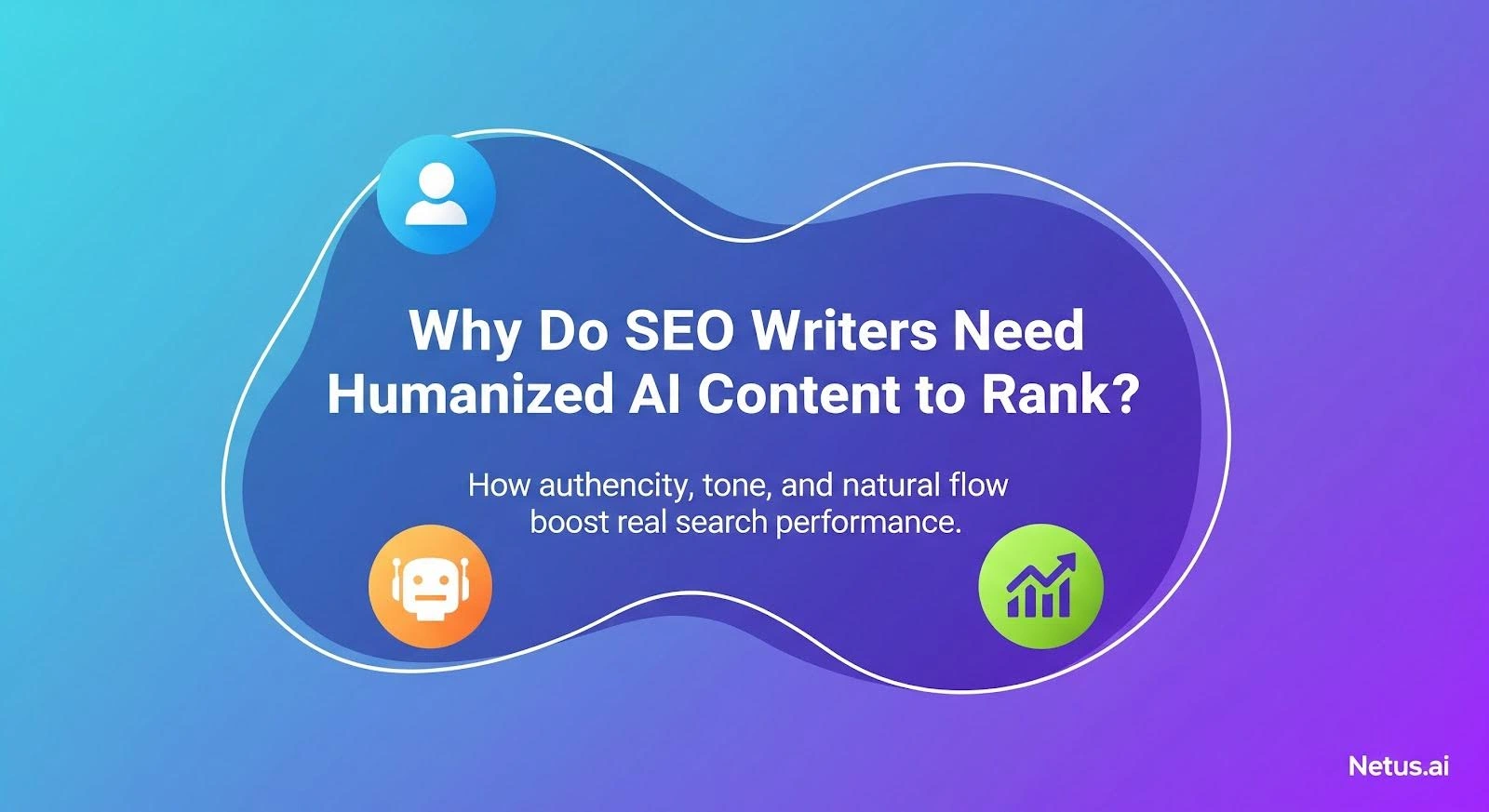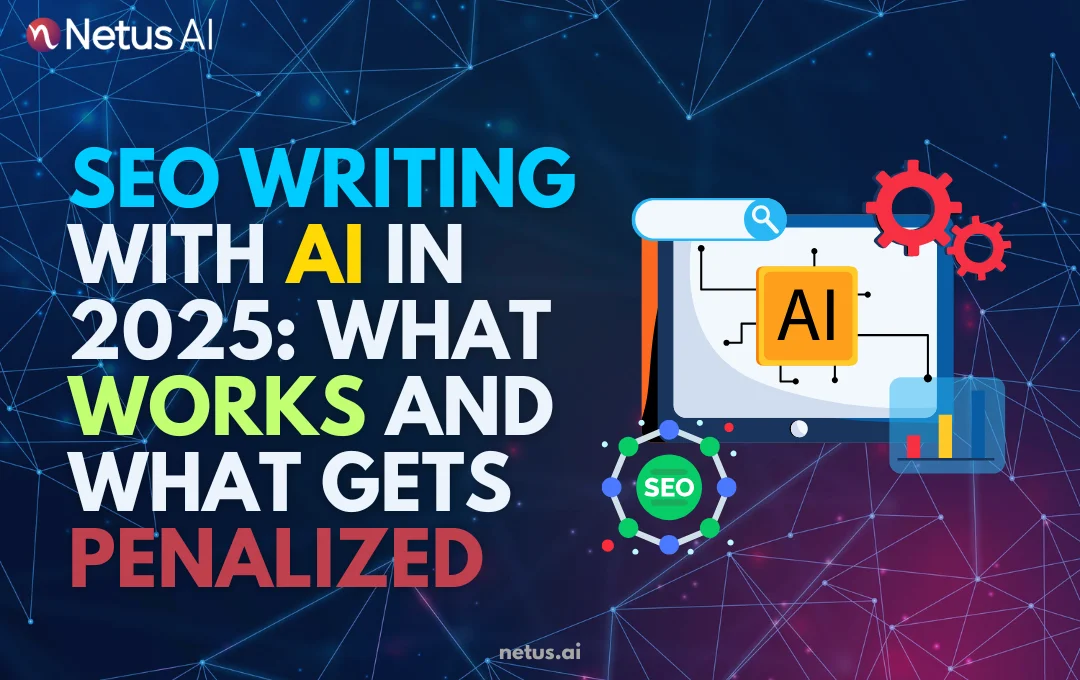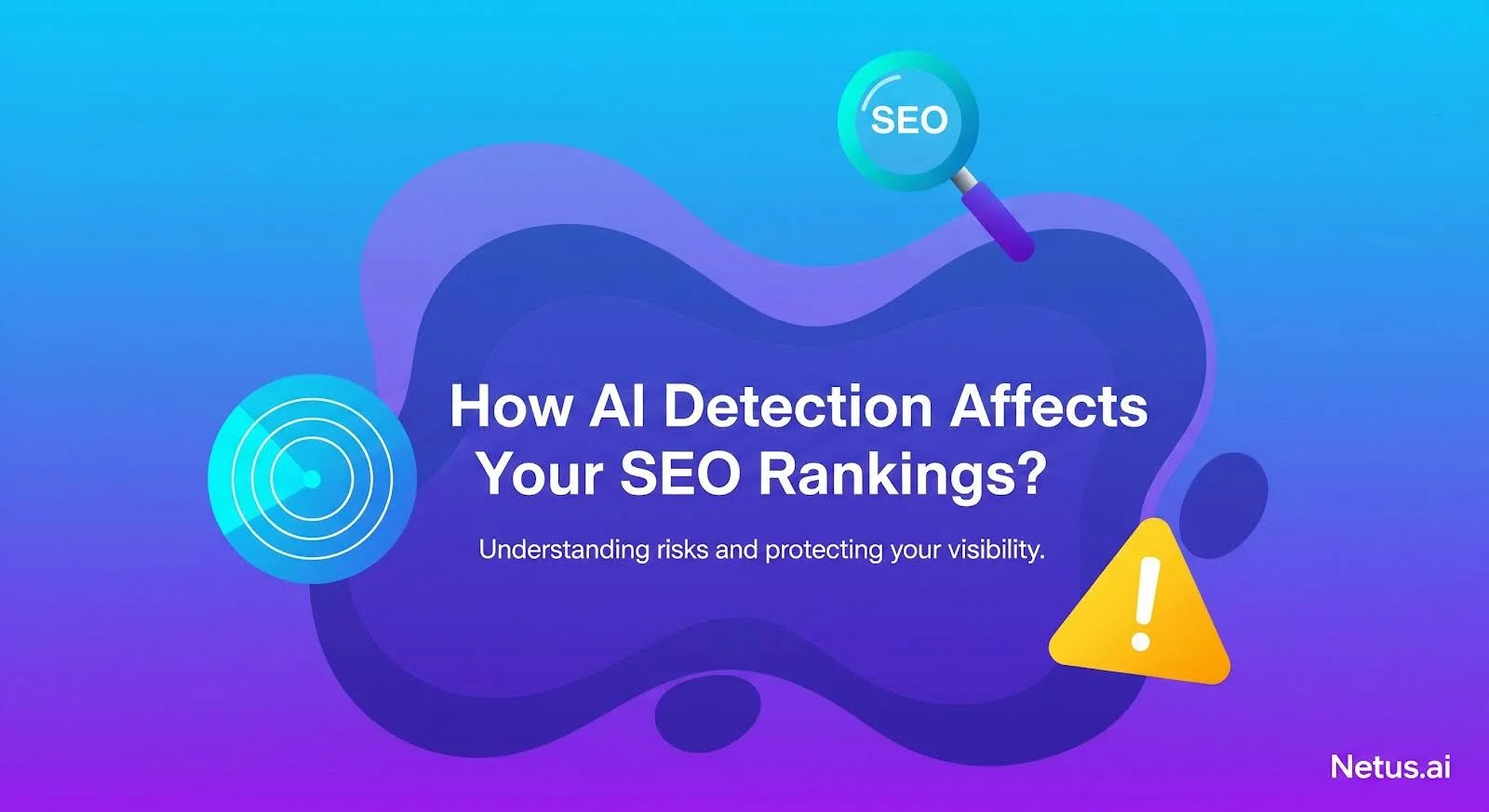SEO writers face relentless pressure from fluctuating rankings and evolving algorithms, demanding vast amounts of fresh content. AI tools initially offered a solution, speed and scale, making high output manageable.
However, the initial promise faded as rankings dropped, engagement declined and bounce rates increased. A new anxiety emerged: the suspicion that Google’s sophisticated algorithms are penalizing AI generated content.
The embraced AI revolution, initially for survival, is now causing an SEO dilemma of diminishing returns.
The crux of the problem: When AI writing screams "robot"
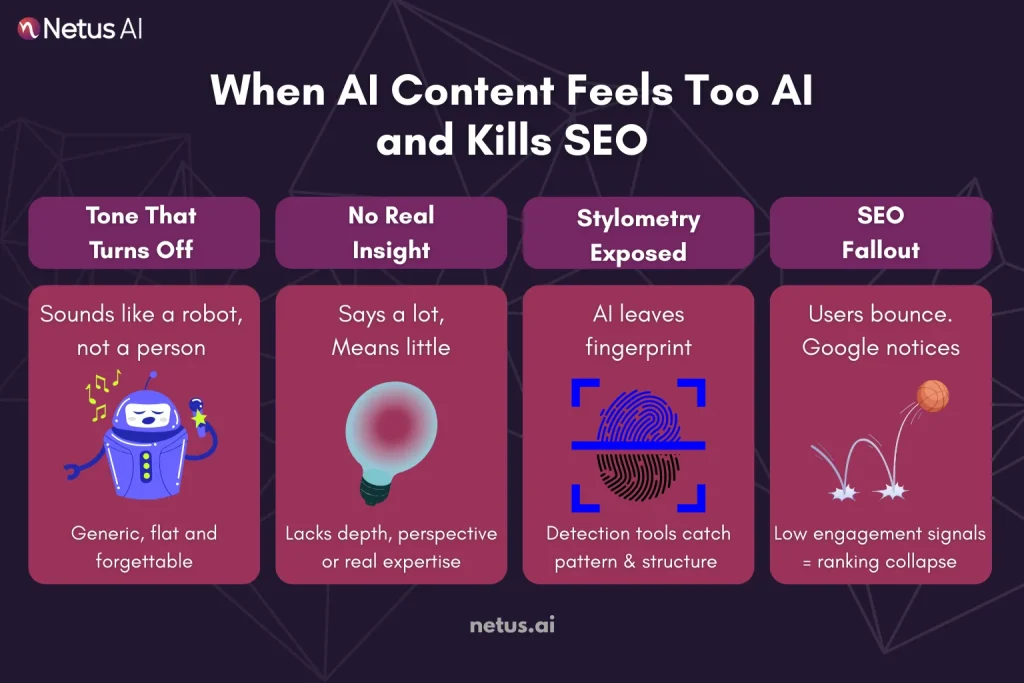
The fundamental issue with raw, unedited AI output isn’t necessarily factual inaccuracy (though that happens). It’s the uncanny valley of content. It looks like writing. It follows grammatical rules. It often even touches on the topic. But it lacks soul. It lacks humanness.
- The tone trap: AI generated content is often generic, bland and overly sterile. Its monotonous, formal or weirdly enthusiastic voice lacks nuance and a unique brand personality, making it untrustworthy and unmemorable.
- Shallow waters, no insight: AI excels at summarizing but lacks genuine insight, deep expertise or unique perspective. This results in content that skims the surface, failing the “Helpfulness” test and leaving readers unsatisfied and clicking away.
- The pattern problem (stylometry bites back): This is where the rubber meets the road for undetectable AI writing. AI models have distinct linguistic fingerprints, predictable sentence structures, overused transitional phrases, specific word choice patterns, even rhythmic quirks.
Sophisticated AI content detection tools (and yes, Google is investing heavily here) use stylometry, the statistical analysis of writing style, to flag these patterns. It’s not foolproof, but it’s getting scarily good. Think of it like a distinctive artist’s brushstroke; once you know it, you spot it everywhere.
Google 2025: The bar is higher than ever (helpful humans win)
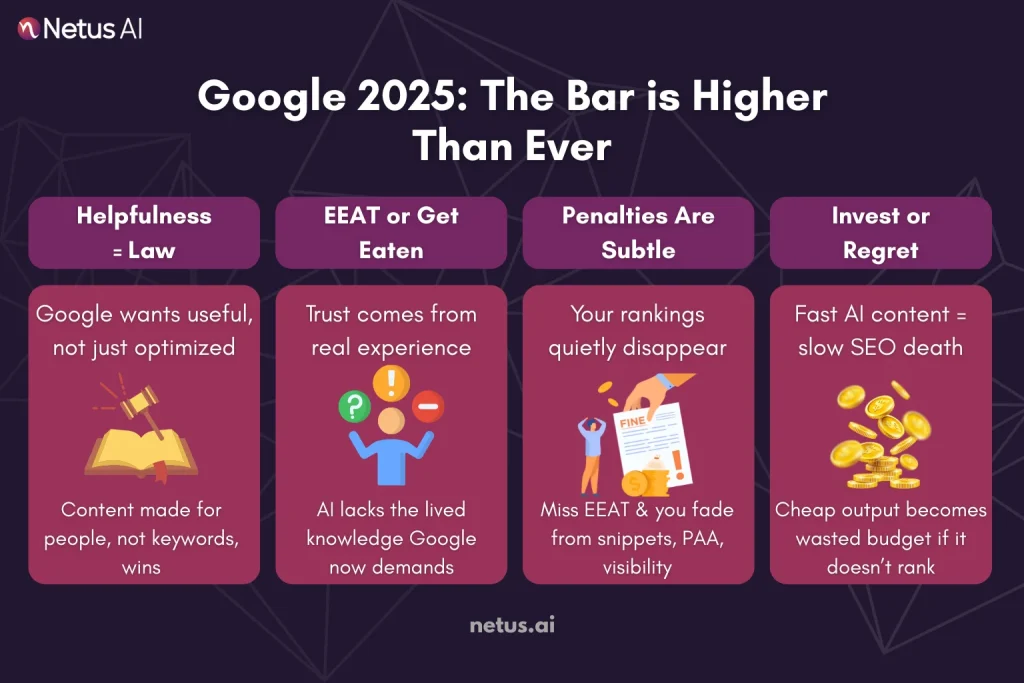
Let’s be crystal clear about where Google stands. Their updates, especially the relentless refinement of EEAT (Experience, Expertise, Authoritativeness, Trustworthiness) and the core Helpful Content philosophy, aren’t anti-AI.
They’re pro-user. Google wants content that demonstrably helps real people solve real problems, written by or deeply informed by those with genuine experience and authority.
- “Helpful” isn’t a suggestion, it’s the law: The Helpful Content System is specifically designed to downrank content created primarily for search engines, not people. Thin, derivative, unoriginal or unsatisfying content, the hallmarks of poorly executed AI, is squarely in its crosshairs. Does your AI generated piece offer unique value beyond what’s already ranking? Does it demonstrate depth? Does it leave the reader genuinely better off? If not, it’s vulnerable.
- EEAT – The trust quadrant: Google isn’t just assessing information; it’s assessing the source and the experience behind it. Raw AI content inherently lacks Experience. Its expertise is synthetic, not lived.
Its Authoritativeness is borrowed, not earned. Its trustworthiness is fragile because it can’t genuinely vouch for anything. Content failing EEAT signals, especially in YMYL (Your Money or Your Life) niches, faces an uphill battle and is prime fodder for manual reviews or algorithmic demotions.
- The cost of getting it wrong: The penalties aren’t always dramatic “manual actions” (though those happen). More often, it’s death by a thousand cuts: gradual ranking declines, loss of featured snippets, disappearance from “People Also Ask” boxes and ultimately, invisibility for your target keywords.
Relying on detectable, robotic AI is a gamble with increasingly poor odds in the SEO content writing arena. The investment in creating that content, even if fast and cheap, becomes a sunk cost if it doesn’t perform.
Humanized AI content: The only viable path forward
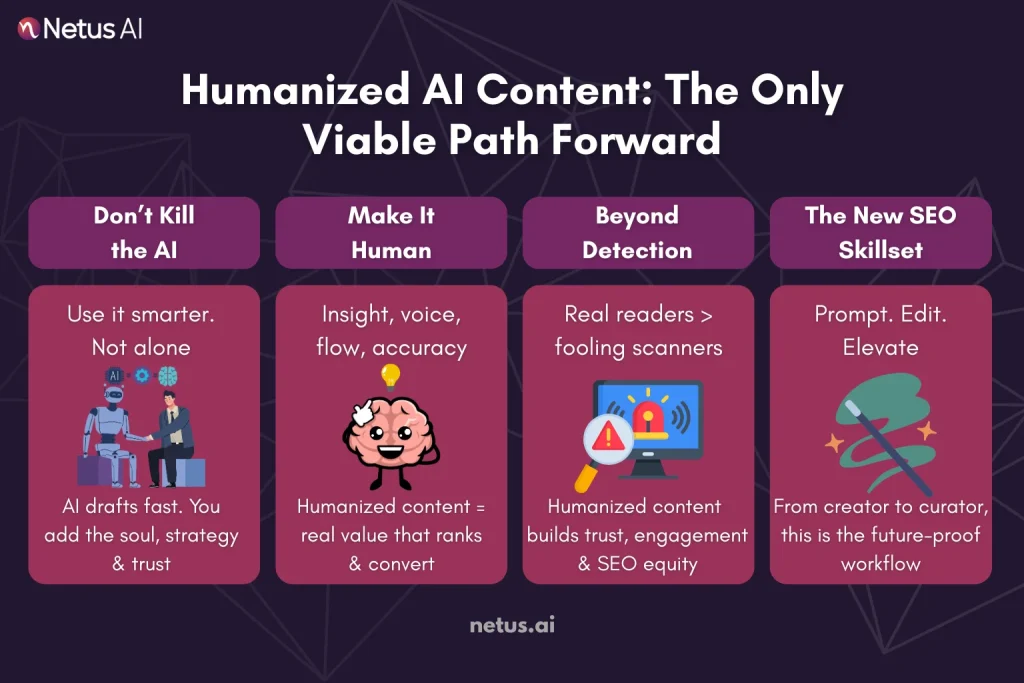
This isn’t about abandoning AI. That’s like refusing to use a word processor. The smart move, the essential move for modern SEO content writing, is strategic augmentation.
It’s about transforming raw AI output into humanized AI content that satisfies both users and algorithms. This is where the concept of an AI humanizer tool or, more accurately, a humanized AI process becomes critical.
Humanization isn’t just swapping a few words. It’s a deep infusion of human qualities:
- Injecting real expertise & insight: This is non-negotiable. Use AI for the heavy lifting of research and structure, but then layer in your unique perspective, case studies, original data, counter-arguments and practical takeaways born from actual experience. Answer the “So what?” that AI often misses.
- Crafting a compelling, authentic voice: Avoid a robotic tone. Write professionally, but conversationally, using contractions, varied sentence structure and strategic humor or wit. Infuse your brand voice consistently. If it doesn’t sound natural when read aloud, rewrite it.
- Prioritizing depth & originality: Go beyond the surface-level summary. Add unique examples, delve into nuances, explore edge cases, connect seemingly unrelated dots. Offer something that isn’t easily found on the first page of results already. This builds EEAT naturally.
- Restructuring for human flow: AI often follows predictable patterns. Break them up. Use engaging subheadings that spark curiosity, not just keywords. Employ strategic storytelling. Ensure logical transitions that guide the reader smoothly, not mechanically.
- Ruthless fact-checking & editing: AI hallucinates. It makes confident, incorrect statements. Verify everything. Edit for clarity, conciseness and impact. Trim the fluff AI loves to generate. Polish relentlessly.
Humanizing AI generated text turns it into a valuable asset that is virtually undetectable as AI because it reads genuinely human. This style passes stylometry tests, satisfies EEAT by offering real value and keeps readers engaged.
Content starts at generation: NetusAI’s SEO article writer and content generator
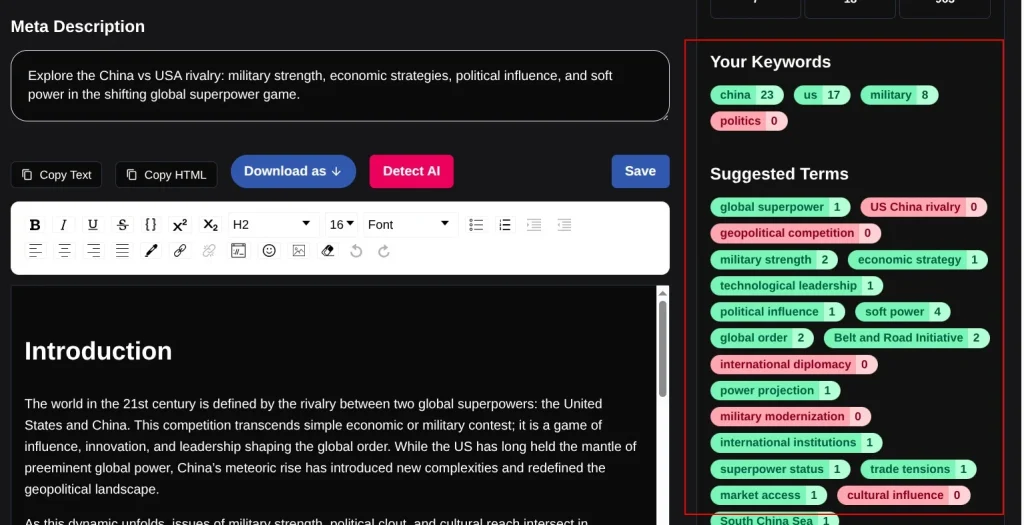
Avoiding stylometry and detection issues shouldn’t begin after content is written, it should start with the writing itself. That’s where NetusAI steps in.
Unlike generic AI tools that churn out robotic, easily flagged paragraphs, The NetusAI SEO Article Generator is designed to help you create full-length blog posts that are already optimized for clarity, tone and search intent. Unlike generic tools, it goes beyond simple drafting. It:
- Lets you input headlines and targeted SEO keywords
- Supports long-form templates for full blogs
- Auto-generates a structure with Title → Outline → Content
- Works in multiple languages for global teams
And most importantly: it ties directly into the Netus AI Bypasser + Detector system, meaning your output isn’t just readable, it’s already tuned to avoid detection.
You can generate, review and rewrite all in one interface without needing third-party tools to patch the gaps. It’s built for marketers, freelancers and bloggers who want their AI content to actually pass as human-written.
Content generator
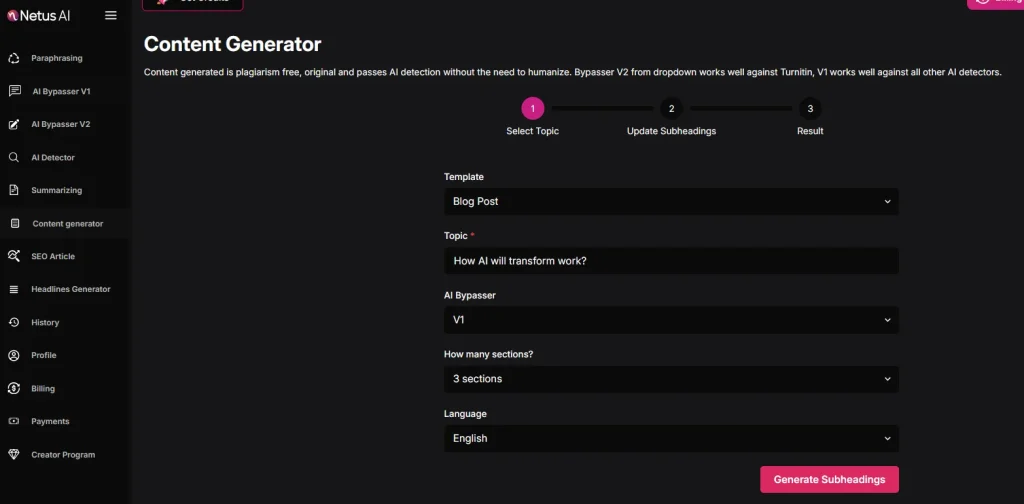
NetusAI also offers a Content Generator. Following the simple steps as shown on the user-friendly NetusAI page, Plagiarism Free Content will be generated from the beginning. The result generated can be downloaded and copied directly as well. Users can easily view their results as they will be stored in the history tab.
So whether you’re starting from scratch or turning an idea into a full SEO article, NetusAI saves you time and rewrites, without sacrificing trust or quality.
Final thoughts
AI isn’t the enemy of SEO; lazy content is. Google prioritizes clarity, intent and originality, which AI alone often misses. SEO writers must combine AI’s speed with human expression. Humanized AI content is the hybrid solution for fast, helpful and non-robotic results.
Tools like NetusAI support this with structured writing, plagiarism-free generation and detection/fixing capabilities.
FAQs
Humanized AI content refers to AI generated text that’s been restructured, rewritten or polished to read like it was written by a real human, with emotion, logic, tone variation and clear intent.
Because detectable AI content can trigger Google’s Helpful Content filter, harming your rankings. Humanized content ensures originality, depth and readability, all key for SEO success
Yes. Google uses semantic analysis, stylometry and content patterns to flag low-quality or obviously AI-written material, especially if it lacks helpfulness or originality.
Risks include poor rankings, higher bounce rates, loss of reader trust and potential manual penalties from Google if content is deemed unhelpful or spammy.
NetusAI offers an AI Bypasser and Paraphrasing tool that rewrites text structurally, changes tone and preserves meaning, all while helping it pass AI detection tools like OriginalityAI and ZeroGPT.
Paraphrasing changes sentence structure or words. Humanizing goes further, improving flow, logic, emotional tone and personal relevance
Not necessarily better, but faster. When done right, humanized AI content can match human writing in quality while drastically reducing writing time.
Absolutely, in fact, it ranks better. As long as the content is helpful, relevant and authentic, Google rewards it, regardless of how it was created.

